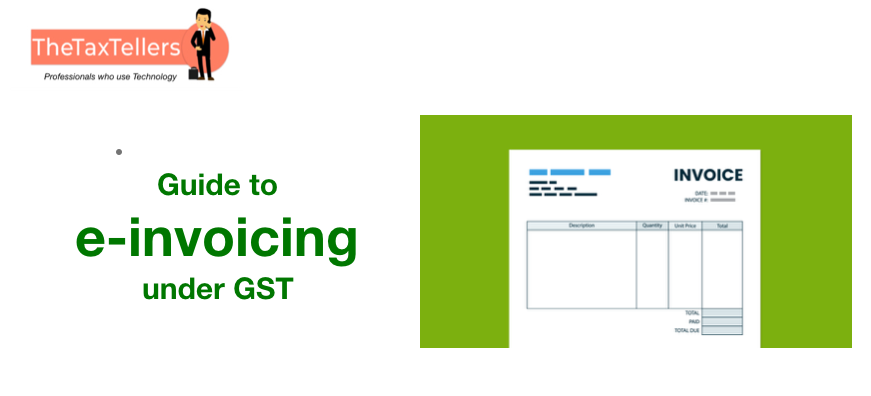GST Council has proposed that the electronic invoicing (e-invoice) system to be implemented on a voluntary basis from January 2020. Until now, there have been no standards set for e-invoicing in India. After consultation with the relevant trade and industry bodies, as well as the Institute of Chartered Accountants of India (ICAI), the GST Council approved of the standard for e-invoicing in its 37th Council meeting held in September, in Goa.
GST has been an eye catching since its inception whilst addressing a lot of historical issues that were against the idea of one nation one tax. However, the loopholes and menaces which come consequent of the new laws like fake tax credits, duplicate invoices got the government and called for action.
Recently, the government came up with rule of e-invoicing wherein invoice has to be raised through the GST portal. This rule shall be made compulsory from 1st April 2020 until then it is made optional. Key highlights of the e-invoicing are as follows:
- The invoice shall be prepared by such class of registered persons in FORM GST INV-01 after obtaining an Invoice Reference Number by uploading information contained therein on the Common Goods and Services Tax Electronic Portal in the manner and subject to conditions and restrictions as specified via a notification:
- Taxpayers whose aggregate turnover in a financial year in respect of supply of goods or services or both exceeds Rs. 100 crores to a registered person.
- Any invoice issued by such class of registered in any manner other than the manner specified shall not be treated as a valid invoice.
- Further, the provisions of regular invoicing and particulars to be contained therein as specified under sub-rules (1) and (2) of section 48 shall not apply to such e-invoice.
- Further, an invoice issued by a registered person with aggregate turnover in a financial year above Rs. 500 crores to an unregistered person (i.e. B2C invoice) shall have a Quick Response (QR)code: Provided that where such registered person makes a Dynamic Quick Response (QR) code available to the recipient through a digital display, such B2C invoice issued by such registered person containing cross-reference of the payment using a Dynamic Quick Response (QR) code, shall be deemed to be having Quick Response (QR) code. 2. This notification shall come into force from the
What is an e-invoice?
Direct creation/generation of e-invoice from GST portal or any other government portal is not envisaged/planned. For a layman, E-invoice will not be different from a current invoice, and does not mean generation of invoices from a central portal of tax department. Requirement of an invoice are different for each industry, hence, Generation of invoice will not benefit trade but create unnecessary restriction on it.
In order to ensure interoperability of the data, it was necessary to standardise the format in which electronic data of an Invoice will be shared, hence a change will be required in softwares which would adopt the new e-Invoice standard wherein they would re-align their data access and retrieval in the standard format.
What would be the process of raising an invoice under e-invoicing system?
The GST portal or Invoice Registration Portal (IRP) will NOT provide facility to generate invoices. IRP is only to report the invoice data.
Accordingly, the invoices are robe generated by taxpayer on his software himself using the schema provided by GSTN. The Process of raising invoice would be as follows:
Step 1: Generation of the invoice (conforming to the e-invoice schema (standards)) by the seller in his own accounting or billing system with mandatory parameters (it can be any software utility that generates invoice including those using excel or GSTN’s provided Offline Utility). The invoice must that is published and have the mandatory parameters. The supplier’s (seller’s) software should be capable generating a JSON of the final invoice that is ready to be uploaded to the IRP. The IRP will only take JSON of the e-invoice.
Step 2: Generating unique Invoice Reference Number (IRN). This is an optional step. The seller can also generate this and upload along with invoice data.
Step 3: Uploading JSON of the e-invoice into the IRP by the seller. The JSON may be uploaded directly on the IRP or through GSPs or through third party provided Apps.
Step-4:
- IRP will perform its checks to ensure that same invoice is not being uploaded again.
- IRP will add its signature on the Invoice Data as well as a QR code to the JSON. QR code will contain GSTIN of seller and buyer, Invoice number, invoice date, number of line items, HSN of major commodity contained in the invoice as per value, hash etc.
- The hash computed by IRP will become the IRN (Invoice Reference Number) of the e-invoice which shall be unique to each invoice.
Step 5: Sharing of uploaded data with GST and e-way bill system
Step 6: Returning the digitally signed JSON with IRN back to the seller along with a QR code and sending of registered invoice to the seller and buyer on their mail ids provided in the invoice.
Where will the e-invoice required to be reported for IRN and generation of QR code?
E-invoice can be reported from any of the below mentioned websites:
www.einvoice1.gst.gov.in; to www.einvoice10.gst.gov.in;
For more details or queries, please login to www.taxtellers.com and raise a query to your dedicated Teller or contact us at info@taxtellers.com

